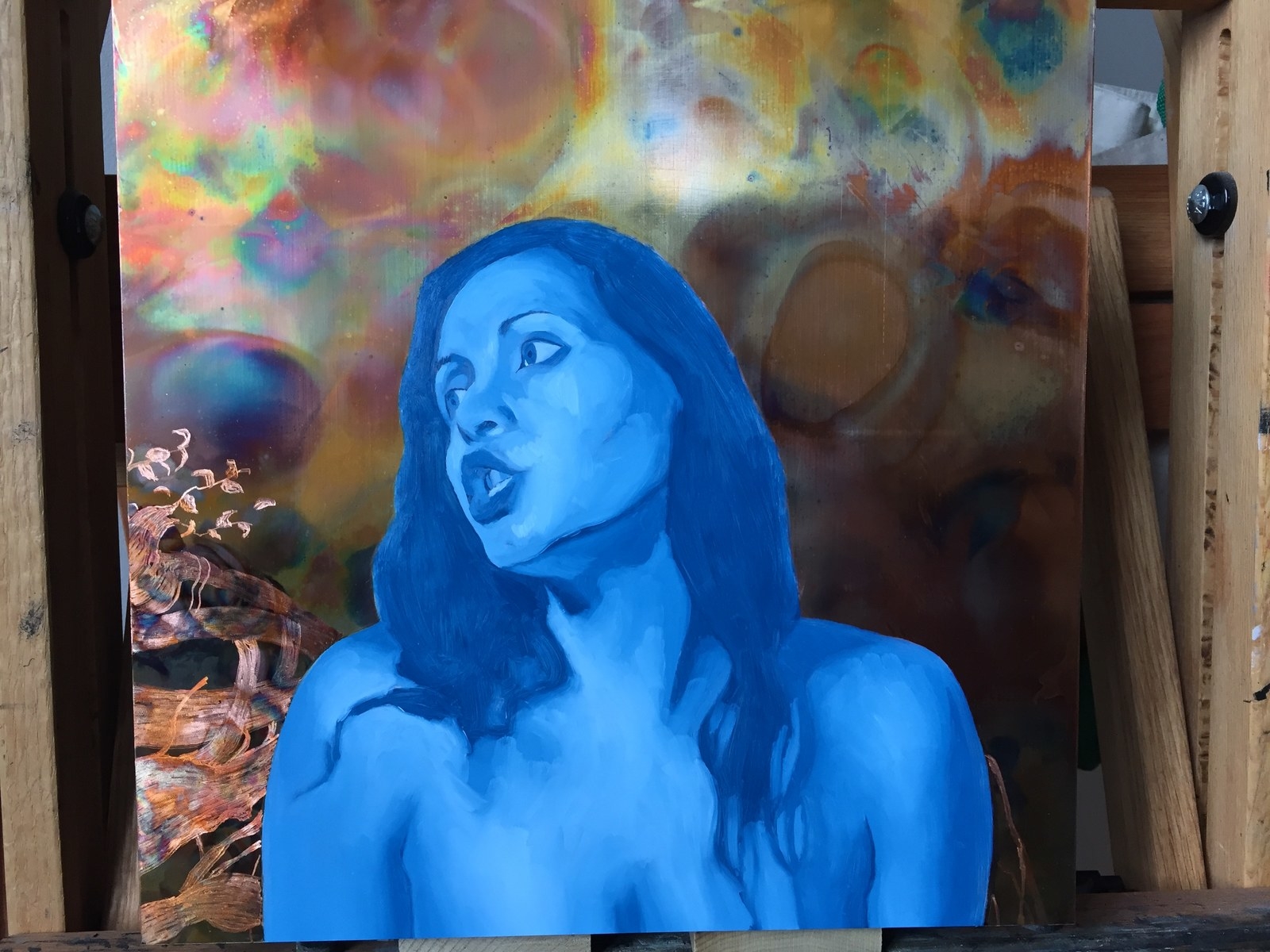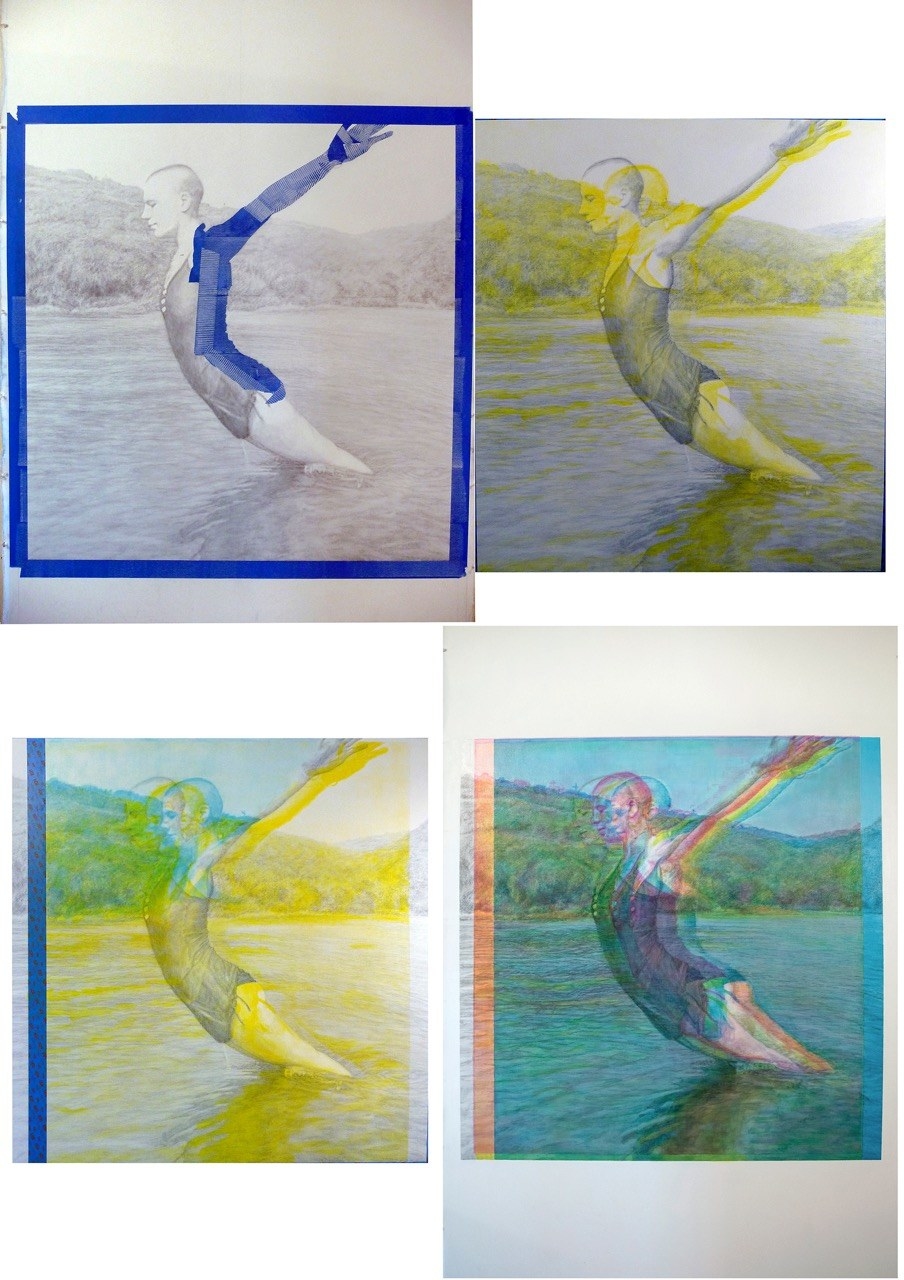Art Periods And Contemporary Art
As artists grow with their careers, their style of work can't help but change. This allows an artist not to become stagnant and for previous collectors to keep coming back and for new ones to be acquired. For example Pablo Picasso went through the Early Works, to the Blue, Rose, African, Cubism, Classicism, Surrealism, War, and finally the later works which were whatever he wanted to paint because after all, he was Picasso. We are going to look through some new techniques being used by contemporary artists as they explore ways of elevating their work. Sometimes it is just a matter of changing the color palette. Other times it is more complex like adding heat and pouring a solution to the surface.
Hollis Dunlap
Color is interesting to Hollis Dunlap who has a solo show coming up soon at Sirona Fine Art. He posted on Facebook recently that he has 25 new works. One of the works he posted Electric Blue was selected for PAINTING THE FIGURE NOW exhibition at the Wausau Museum of Contemporary Art.
He says that his palette is not limited and that is a term he never uses but others do to try to describe his style. He is a classical painter and also a teacher. Working with brighter colors not only seems to work well with the modernization of ways to use paint but it also seems to garner attention yet it keeps his classical painting style intact.
With these new blues, he has taken to drawing sometimes on the canvas to get a better feel and get the shapes correct. Normally he just starts painting directly onto the canvas which works well with his frantic style. He says he normally doesn't have the patience to stick with underdrawings. He spends time revising and repainting areas and a work of art could take from a few hours to a month. Although he has been working on just one piece for years.
He switched his colors recently from the more subtle darker palette to these new vibrant and electric schemes. He explains: "These colors are actually colors that I used years ago, but I wasn't happy with so I simplified. I was looking at paintings by Sargent and it helped me to get rid of the really bright colors. Then I started to think Sargent was boring and I thought I'd start brightening things up."
When his work was being described as "limited palette" he decided to change because the word "limited" to him implied losing something. He'd rather think about what can be achieved with colors, as opposed to what can't be. He still loves working with traditional colors so he will work alternatively depending on what he feels the painting needs. He continues, "the colors I use give me the maximum range with the simplest setup. For example, Ultramarine Blue is very versatile. If you use it with a bright yellow, you can make almost any green. If you mix it with a permanent rose, you can get almost any violet. But it also mixes very well with earth tones like burnt sienna, to make beautiful subtle grays. Many people would buy a separate green, rather than mixing one, but if you mix one, there is a subtle effect on the harmony of the overall painting since you are using the same pigments throughout. Most people don't notice it, but I do, and it's important to me for the overall effect. Many people notice the brighter colors more easily, but subtle greys are really the key to good color (for me). Then again, there really aren't any limits. Its all about coming up with a color scheme that is pleasing to the eye."
We will call his bright colors period "psychedelic".

Erin Anderson
Erin Anderson's original medium was oil on gessoed masonite. She was attracted to copper because of its reflective qualities. The reflective qualities caused her paintings to become interactive with the viewer. By having the interactive reflective qualities from the copper the viewer can't help but become part of the artwork.
In a recent interview with Coumbustus Magazine she says, "Picking up energy in others or your surroundings are essential functions of intuition. The more we can intuitively know about others, the better we can understand how to interact with them and empathize with their experience."
She became interested in how various solutions when poured on the copper would ignite various shapes and colors. Although the use of copper has been used for hundreds of years, Erin is interested in taking a very traditional material and making it contemporary. She keeps stretching the use of copper and recently has been using heat to bring out a rainbow effect.
Most of Erin's subjects are nudes. Because the colors in the copper are so warm she recently wanted to have something that lent a cool element in the subject so she started using blue for the underpainting. Once the paint dries she will add skin tones. The work-in-progress below is not finished and we will have to wait to see if this effect will release several new works. If this series takes off, we will call this period of her work "fire and ice".

Joshua Dean
Joshua Dean is interested in the interaction with digital images and traditional mediums. By interweaving aspects of historical and digital photography he has created a new technique functioning as a human printer.
Similar to the technique Chuck Close worked with in the 1970's to achieve photorealism of his large scale portraits, Dean uses only four colors: cyan, magenta, yellow and black. Each color is applied independently. In this scheme, the first layer, black, mimics the function of the grisaille underpainting. Then he transparently layers the cyan, magenta and yellow over the top of each other. It is an additive process that allows for progress in only one direction. The painting develops in the same manner that a print would, left to right, as if it were the output of an ink jet printer.
According to Dean, the application can be imprecise, which leads to imperfections and hopefully more expressive art. The finished painting hangs like a tapestry, floating away from the wall similar to a movie screen. It sways slightly if someone walks by, disrupting its ether. We will call this period of works for Dean "the digital age".

Candice Chovanec
While the paint dries on Candice Chovanec's larger works, she experiments on smaller works changing the colors and paint applications. Currently she is trying to achieve the texture of skin. She recently took a class with Steven Assael who is a master using this technique.
She starts with a thin layer of red tone for the underpainting. She then waits for the first layer to dry before applying the paint again rotating thicker paint around to create a more realistic texture. She then waits a day so the paint has settled and starts sculpting the paint around the cheeks.
She will then wait for the layer to dry completely before adding a thicker layer to the nose, top of cheeks and mouth so the paint extends from the canvas to make it seem more like an oil painting sculpture. Working this way, she has to plan ahead and have self control, but if it all works out she will then use it out on one of her larger scale figurative artworks. Let's call this period in Candice's work, "the fleshies".

Jennifer Hartzler
Jennifer Harztler is combining media to her oil paintings such as colored pencils, oil pastels, stencils, spray paint as well as incorporating childlike drawings into the mix. She says, "I think using them all together while painting a traditional subject matter (I.e. the figure) makes the work more accessible to the general public and those who feel intimidated by art in a gallery setting." We will call this period and phase in her work "child's play".
Laurence de Valmy
Laurence de Valmy's new series POST is recycling the work of previous artists. To do so she has to use different techniques and make reproductions of the works which were painted in either in oil, pastel, encaustic or gold leaf and uses acrylics to mime the original effects. She says it is fun for her to show that acrylic can have a wide range of use. She then paints comments under the paintings as if these classical painters were around today's social media. We will call this period of her work "past and present future".
Become a Community Contributor.

